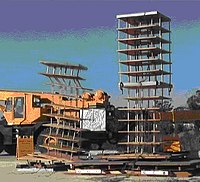
Photo from wikipedia
While unprecedented amounts of building damage data are now produced after earthquakes, stakeholders do not have a systematic method to synthesize and evaluate damage information, thus leaving many datasets unused.… Click to show full abstract
While unprecedented amounts of building damage data are now produced after earthquakes, stakeholders do not have a systematic method to synthesize and evaluate damage information, thus leaving many datasets unused. We propose a Geospatial Data Integration Framework (G-DIF) that employs regression kriging to combine a sparse sample of accurate field surveys with spatially exhaustive, though uncertain, damage data from forecasts or remote sensing. The framework can be implemented after an earthquake to produce a spatially distributed estimate of damage and, importantly, its uncertainty. An example application with real data collected after the 2015 Nepal earthquake illustrates how regression kriging can combine a diversity of datasets—and downweight uninformative sources—reflecting its ability to accommodate context-specific variations in data type and quality. Through a sensitivity analysis on the number of field surveys, we demonstrate that with only a few surveys, this method can provide more accurate results than a standard engineering forecast.
Journal Title: Earthquake Spectra
Year Published: 2020
Link to full text (if available)
Share on Social Media: Sign Up to like & get
recommendations!